I attended my best friends’ traditional wedding. During the Buddhist religious ceremony I thought I would like to share this with everyone, so here I am.
Currently the engagement ceremony and the wedding ceremony combine to a single day for simple process. Both my friend’s engagement and wedding ceremonies were held at her house. The bride had 14 bridesmaids so we had to wake up at 3 a.m. to get ready (you know…makeup, hair, dress, and all that girl stuff) because the buddhist ceremony was scheduled to start at 6 a.m. (The Buddhist ceremony usually begins early in the morning, approximately 6-7a.m.)
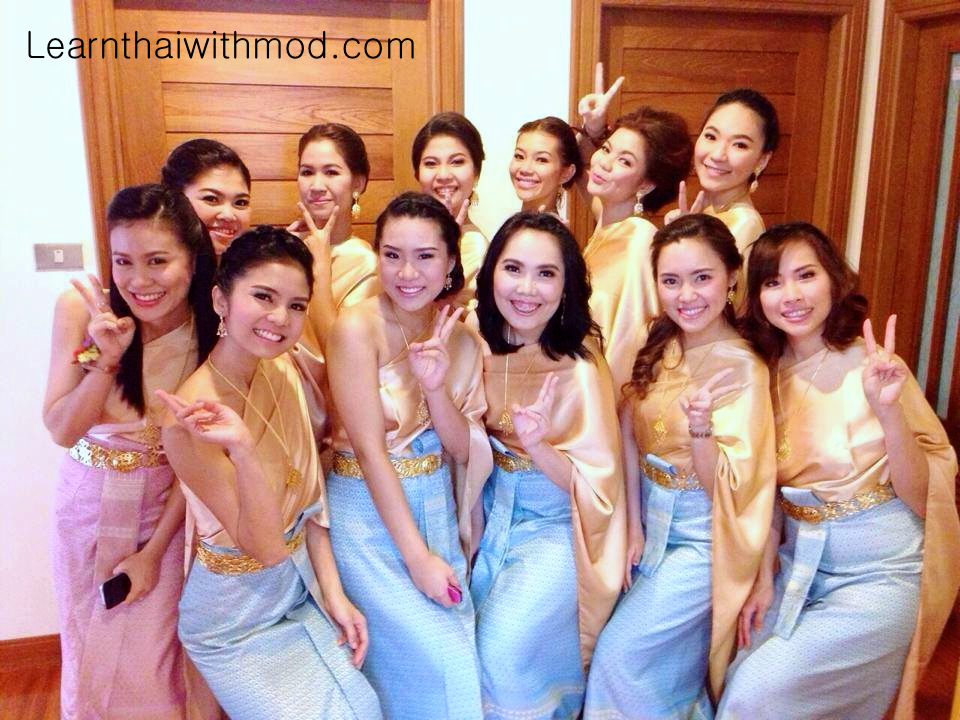
1. Thai Buddhist Blessing
In the past, even numbers of monks such as four or eight were invited. However, nowadays Thai people believe that number nine is a lucky number. Accordingly, nine monks are usually invited, and with one Buddha image at the ceremony this comes to ten, thus making even number. The couple also invited nine monks to their ceremony. The monks chanted whilst a lit candle was placed in a bowl of water. This lustral water was then used later to bless the couple. A bowl of white paste was also blessed which was used later to anoint the foreheads of the bride and groom.
After the chant finished, the wedding couple and their relatives offered food to the monks. Nobody else is permitted to eat until the monks have finished their meal. Then the monks left the ceremony.
2. Engagement Tray (Khan Mak)
According to Thai customs, a couple traditionally becomes engaged during a ceremony known as “Kan Maak“ (ขันหมาก /kăn-màak/). ขัน/kăn/ means ‘bowl’ and หมาก /màak/means ‘betel nut’; ‘Kan Mak’ means “bowl of betel nuts” .
Things to put in the Khan Mak tray may vary by culture in different regions. These items represent important aspects of the marriage, such as health, prosperity, fertility and longevity. Generally items in the Kan Maak tray are ;
- The young betel nuts (หมาก màak) 4 or 8 pieces
- Betel leaves (ใบพลู bai pluu)
- Silver bag (ถุงเงิน tŭng ngern) which contains money, usually coins
- Golden bag (ถุงทอง tŭng torng) which contains mung beans, popped rice, sesame seeds
- Meaningful flowers which commonly be;
– Calotropis gigantea (Crown flower) which in Thai is called ‘ดอกรัก dòrk rák’ ; ‘รัก rák’ means ‘love’
– Globe amaranth which in Thai is called ‘ดอกบานไม่รู้โรย dòrk baan mâi rúu roai’ ; the name means ‘always bloom’, so the couple’s love will always bloom.
– Marigold which in Thai is called ‘ ดอกดาวเรือง dòrk daao rueang’ , the name เรือง rueang sounds like the word ‘รุ่งเรือง rung rueang’ meaning ‘prosperous’.
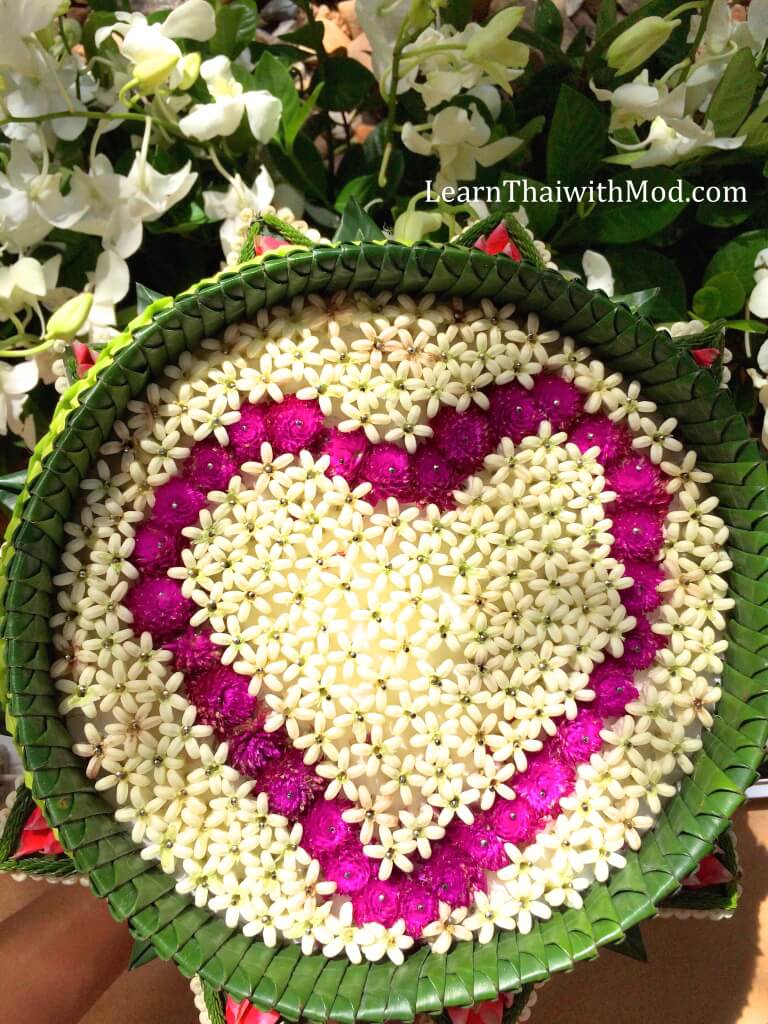
Culture Note: Why betel nuts and betel leaves?
In the old time, Thai people liked to chew betel nuts and betel leaves. They were common items every household had and they were used to welcome the guests visiting the house. Therefore betel nuts and betel leaves are used as a gift to represent harmony in Thai wedding.
3. Khan Maak Procession
When the time comes for this auspicious occasion, the proceeding begins with the arrival of the groom and his entourage at the front of the bride’s house.The procession is lead by the groom’s representative or “เถ้าแก่ Thao Gae”, and his parents, relative and friends also accompany him carrying flowers, incenses, candles and gifts. The parade will be lead by drummers and traditional folk dancers, whose lively celebrations announce their arrival to all around.
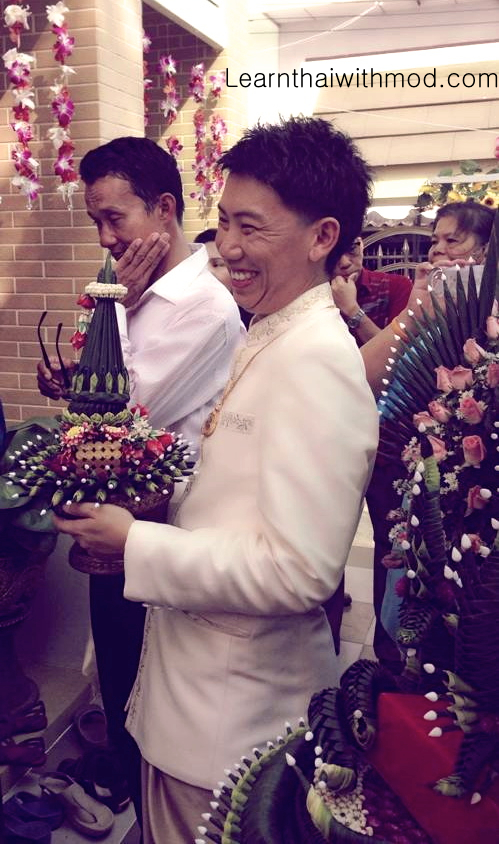
Banana leaves and sugar canes are paraded like banners by some of the attendants, while others bear the traditional gifts of the Kan Maak, which includes rice, sesame seeds, Thai food for the feast and many Thai desserts, as well as monetary gifts and other precious items, such as gold and jewellery, which will make up the dowry to the bride’s parents later on in the ceremony.
Many of these gifts represent important aspects of the marriage, such as health, prosperity, fertility and longevity.
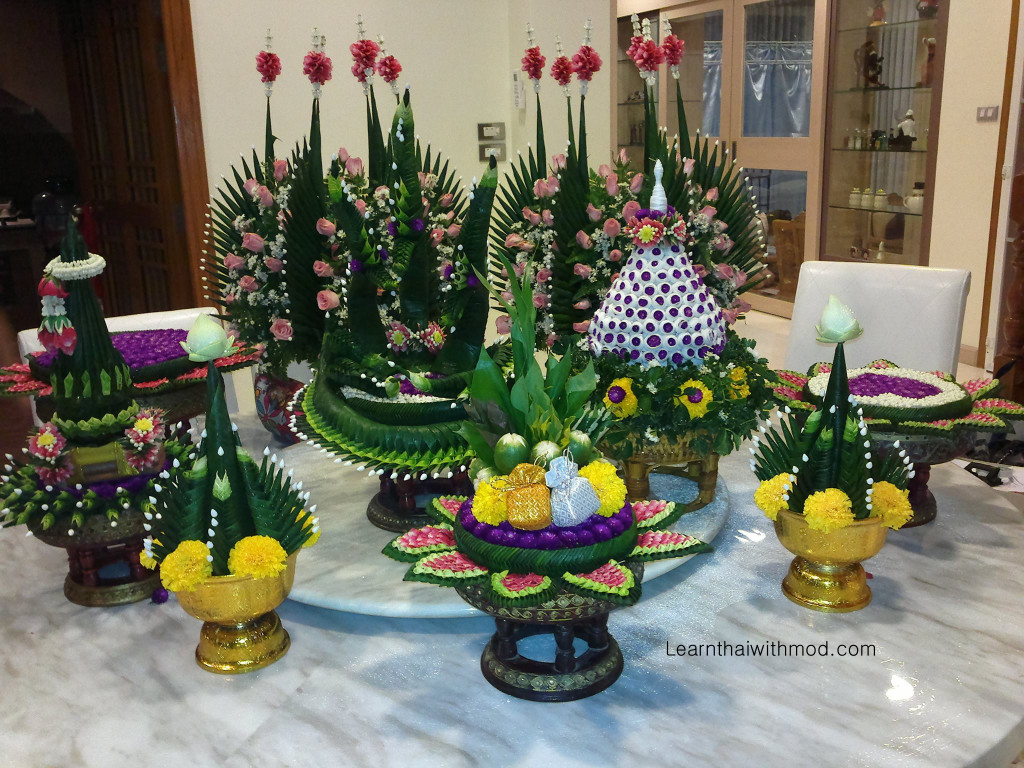
The Thai desserts to be eaten as part of the feast consists of nine different items. The number 9 is important in Thai society and it’s use on occasions such as this is regarded as very lucky.
The timing procession (ฤกษ์) is also important, as it will have been calculated to occur at the most auspicious moment for the couple. It is also common for the lucky number 9 to figure in these calculations as well. My friend’s Khan Mak procession started at 09:09 a.m.
When the procession finally arrives at the Bride’s home they will be met by the bride’s family, who will invite the groom into the home to conduct the next part of the ceremony.
4. Barring the Groom from approaching the Bride (พิธีกั้นประตู)
In order for the wedding to continue, the groom must bring the bride from her room to join him for the engagement ceremony. However, before this can happen, the groom must successfully pass through a number of obstacles that are put in the groom’s way by the bride’s family. These symbolic “doors” can only be entered once the groom has proved his worth to the keepers of the “locks”.
Normally, there are just 3 of these symbolic “doors”, but there may be more. Typically there are gold and silver gates represented by gold or silver belts or necklaces which is held by two female members of the bride’s family or friends. These days the doors are also represented by flower strings. At my friend’s wedding, there were nine doors and they were represented by lovely orchid.
The groom can sometimes be questioned and is occasionally teased during this activity as the family light-heartedly determined whether he can pass through each “door”. His passage to the next “door will only be granted once a “toll” has been negotiated with the keeper of the “lock”.
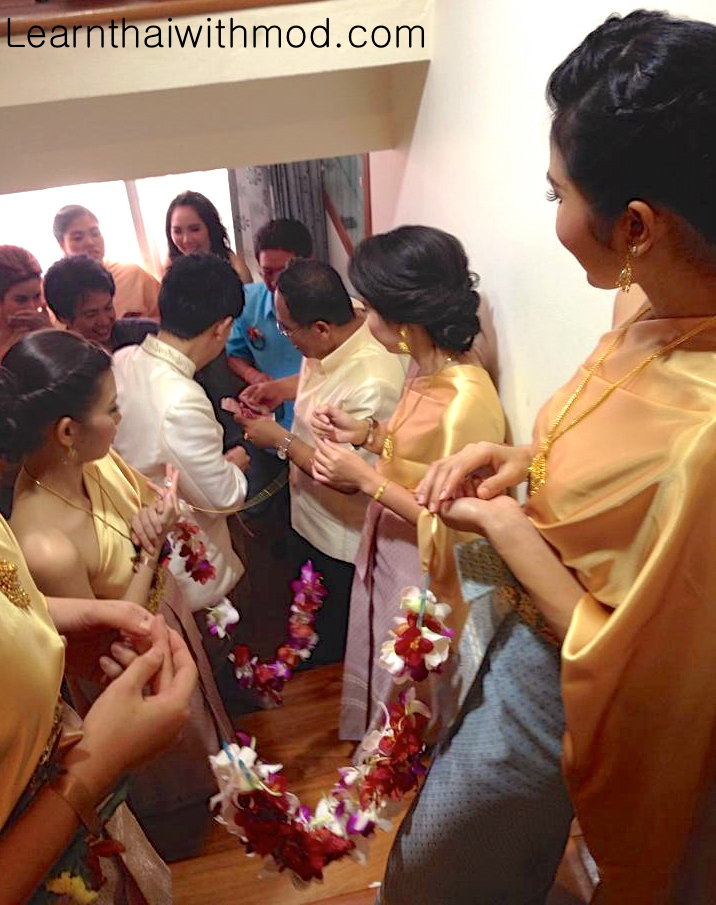
The toll for each subsequent “door” will increase as the groom successfully advances. I saw the doorkeepers of the few first gates got 100 Baht to open the door. I was the guard of the last door, so I accepted 1,000 Baht to let the groom passed.
Depending on circumstances it can either be the groom or his ‘Thao Gae” that hands over the money envelopes to the gate guardians.
This part of the wedding ceremony is the most ‘sanuk’ with plenty of laughter and frivolity most of which comes at the expense of the groom as he is teased and gently ribbed by the bride’s family.
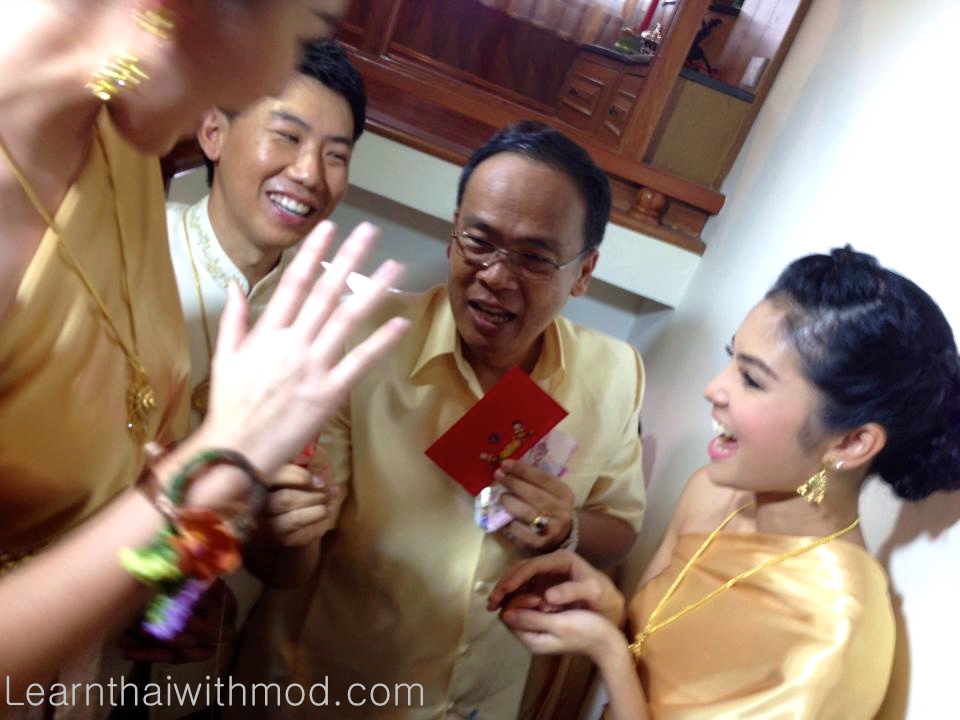
5. Counting the Dowry
Once the gates have been successfully negotiated, the groom can take the bride from her room to continue the next part of Thai wedding ceremony which is the dowry ceremony.
Thai marriage at large and definitely the ceremony of traditional Thai wedding interlinked with an ancient tradition called sinsod (สินสอด). A custom of paying a dowry (dowery) to compensate a family of bride “for mother’s milk”. A concept of sinsod was initially brought in to ensure that one’s daughter does not marry below her potential standing in life. To stipulate that her social, financial and professional status and reputation is preserved and secured.
Traditionally, a downry (สินสอด /sĭn-sàwd/) will be formally presented by the groom’s parents to the bride’s parents on the Kan Maak tray. This dowry will consist of money, gold, jewellery or title deed. The dowry is then counted out onto a red cloth by the bride’s parents. The amount of the dowry is usually predetermined which is intended to represent prospective wealth for the couple.
There is no set amount, the sum of sinsod is typically determined on the one hand by suitor’s perceived wealth, and on the other hand by the “value” of the future wife. Her beauty, personality, background, education and other qualifications, if she is a virgin, or has got a child, and so forth.
Nowadays, many parents-in-law hand the dowry back to the married couple as a wedding gift, some families do not require a dowry, and some need to keep the money. Traditionally, sinsod is reciprocated by the parents-in-law. More often than not, a part of the money is used to pay for the wedding ceremonies, parties and other related expenses. Dowries or sinsod payments range from THB 50,000 to 250,000 and up.
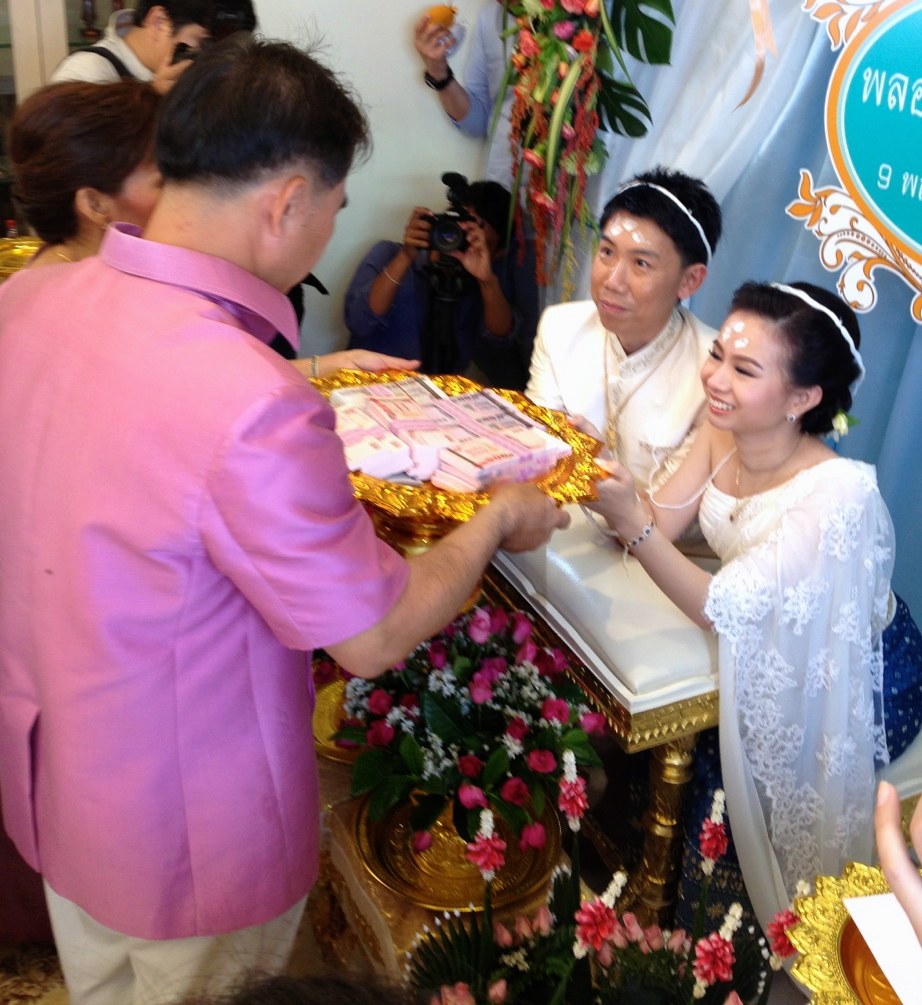
6. The Engagement พิธีหมั้น
Traditionally, the engagement is performed well in advance of the wedding, just as in western culture, but recently, it has become common for it to be carried out on the wedding day after Counting the Dowry.
The engagement is historically a way of introducing the bride to the groom, who has been selected by her parents and gives a chance for the couple to get acquainted before the wedding, but nowadays most couples choose their own partners.
Besides an exchange of rings, the groom also put the jewellery from Sin Sod tray for the bride as well. The exchange is performed in front of the parents of both parties.
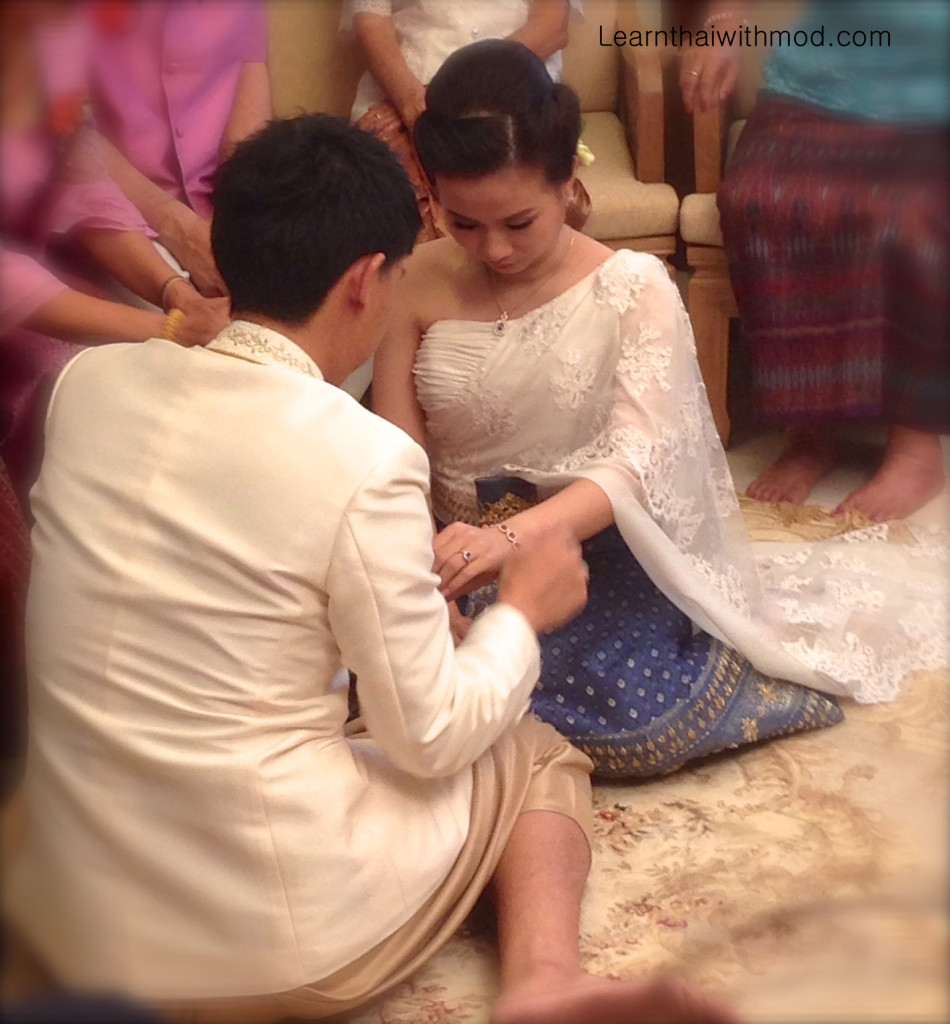
7. The Thread Ceremony & Water Pouring พิธีหลั่งน้ำพระพุทธมนต์
After Sin Sod ceremony is finished, the groom and the bride will get ready for water pouring ceremony.
The water pouring is the most important part of the Thai wedding ceremony as during this part the couple officially become husband (สามี [săa-mii]) and wife (ภรรยา [pan-rá-yaa]). Traditionally, this was all that was required to validate the marriage, but nowadays the couple are also required to obtain a marriage certificate (ทะเบียนสมรส [ta-bian som-rot]) from the Amper or local registration office.
Before the water pouring can take place the couple must seat themselves at the traditional water pouring tables (ตั่งรดน้ำ [Dtang Rot Naam]), with the bride to the left of the groom. They will each have a ceremonial headdress (มงคล [Mong Kol]) , made from one piece of cotton forming a circle and signify the joining of the couple, placed upon their heads. The Mong Kol will have previously been blessed by the Buddhist monks earlier in the wedding.

Then senior members of the family or special guests of honor perform the anointing of the couple’s foreheads with three dots of white powder to represent the shape of a pyramid. Traditionally, this powder is made of dirt or clay, ground, and mixed with holy water and blessed by Buddhist monks. As with all of the ceremony’s traditional customs, the ritual is meant to bring good fortune to the couple.
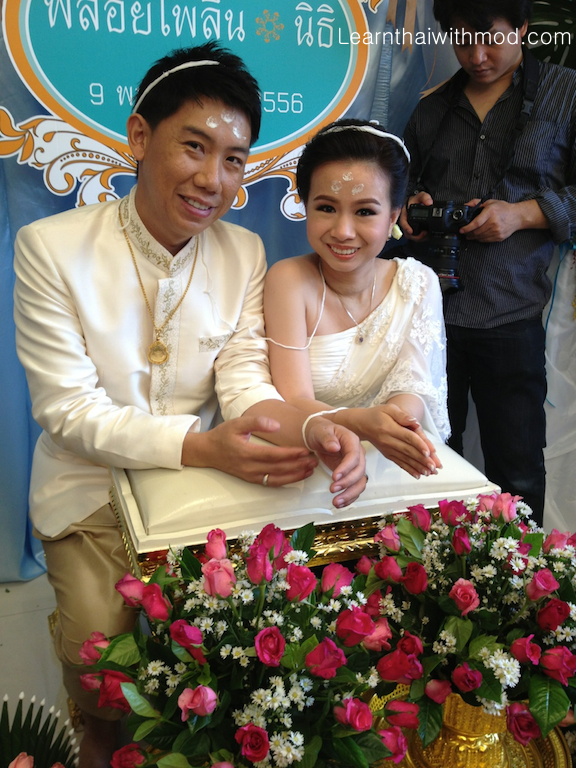
The couple will be fully prepared for the water pouring to commence once they place both hands (palms together), overhanging the water pouring table and positioned above flowers that have been arranged in a water tray, to capture the water that runs off.
Each of the elder guests in turn will take the ceremonial water pouring conch shell (สังข์รดน้ำ [Sang Rot Naam]), which has been freshly filled with holy water from the Buddhist ceremony, and pour a trickle of water from the base of the thumb to the fingertips over first the groom’s and then the bride.
8. พิธีส่งตัว Preparing the Bridal Bed
After the water pouring ceremony is completed. The couple will be sent to their bedroom. This is just a part of the wedding ceremony, they are not going to bed to sleep for real yet. : )
The bed will be prepared by a married couple who have been happily married for a long time. Their knowledge and good luck is then imparted to the newly-weds in a number of different ways. They may say how lucky the bed feels hinting that the newly married couple will have children. Nine meaningful items will be placed on the bed as symbols of prosperity and fertility.
– One big brass tray (พานทองเหลืองใหญ่)
– A mortar as a symbol of steadily love (ครกบดยา หมายถึง จิตใจหนักแน่น)
– A cane as a symbol of long life (ไม้เท้า หมายถึง อายุยืน)
– A a green squash as a symbol of happy and peaceful married life ( ฟักเขียว หมายถึง ความอยู่เย็นเป็นสุข)
– A silver bag and gold bag cantains beans, seasmi seeds and baking powder as a symbol of prosperity ถุงเงินถุงทอง บรรจุถั่ว,งา และผงฟู อย่างละ1 ถุง (หมายถึงความเจริญงอกงามและความเฟื่องฟู)
– A bowl of rain water as a symbol of harmony (ขันใส่น้ำฝน ความสามัคคี ป็นน้ำหนใจเดียวกัน)
– A white cat doll (traditionally the real old cat was used) as a symbol of liking to stay at home (ตุ๊กตาแมวสีขาว หมายถึง รักบ้านเรือน)
– A white chicken as a symbol early rise (ไก่ขาว ตื่นดึก ลุกเช้า)
Tradition states that the newly-weds share their bed with these objects for the next 3 nights.
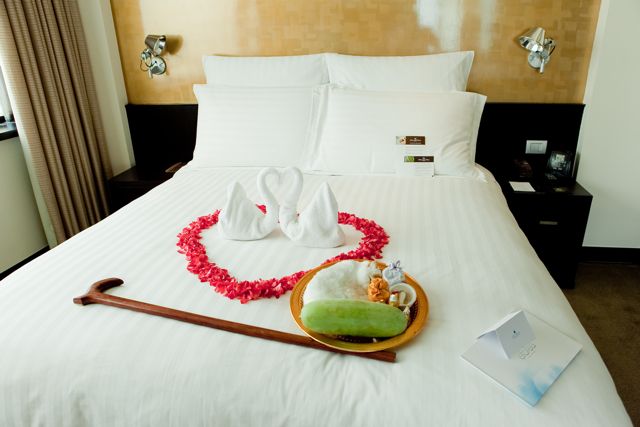
And of course, a lot of happy photos were taken at the wedding 😀
UPDATE (Mach 2016)
Teacher Pear as a bridesmaid at her friend’s wedding:
Thai Culture Fact:
When a Thai couple plan to get married, they need to look for “an auspicious time” (ฤกษ์ rêrk) to get married by consulting a monk or an astrologer to determine the most auspicious day. The couple’s birthdays and time of birth are needed to use for the calculation. Astrologers use lunar calendars to fix auspicious days for weddings, journeys, the dedication of a new house, and similar important occasions.
Have you ever been to a Thai wedding before? Please share your impression. : )
YOU MIGHT ALSO LIKE:
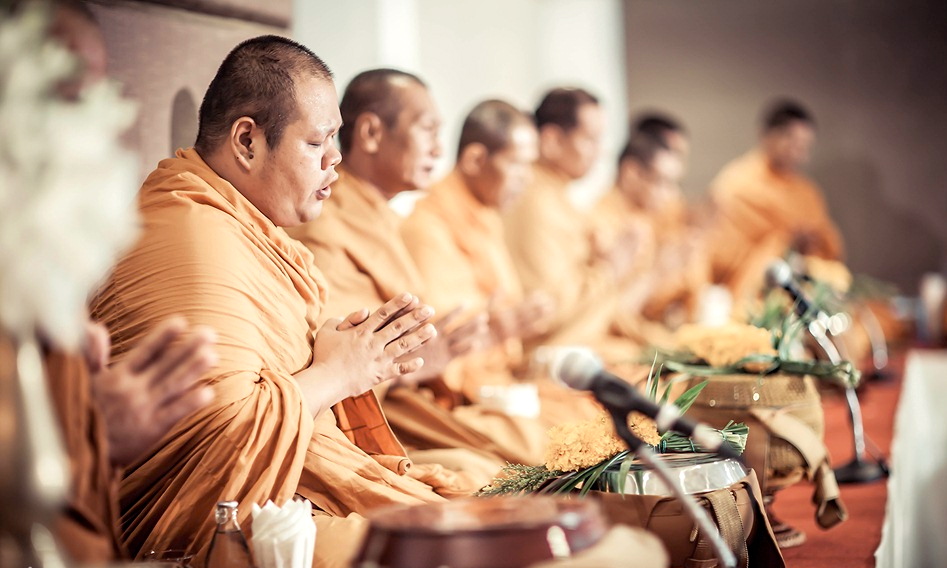
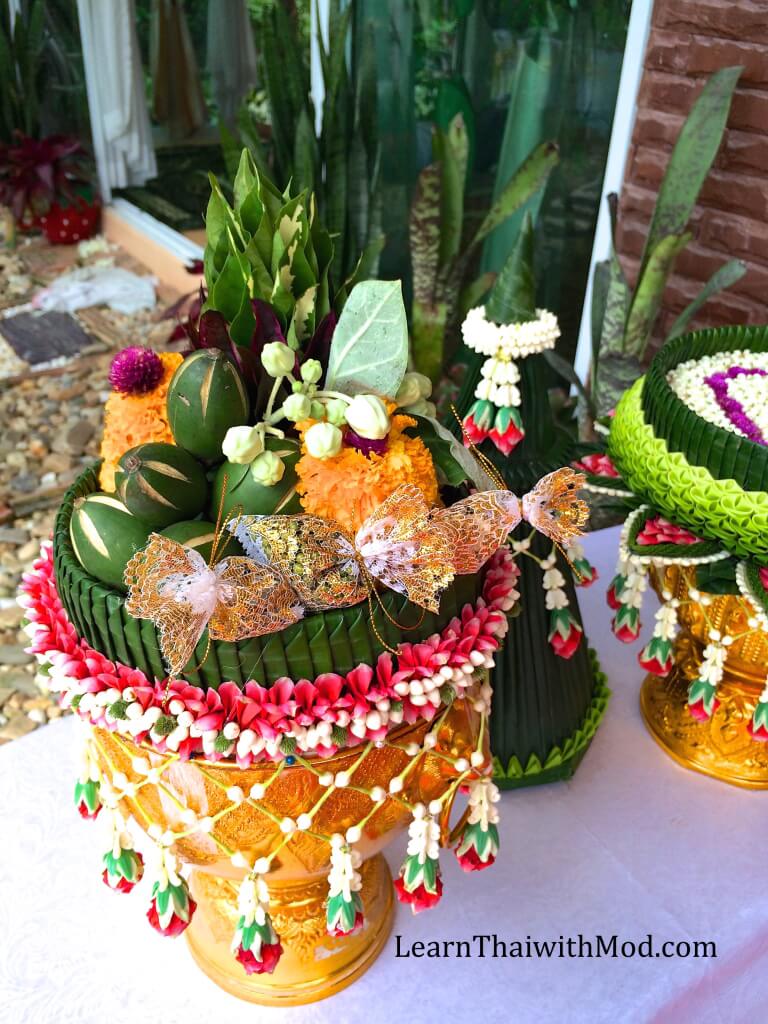
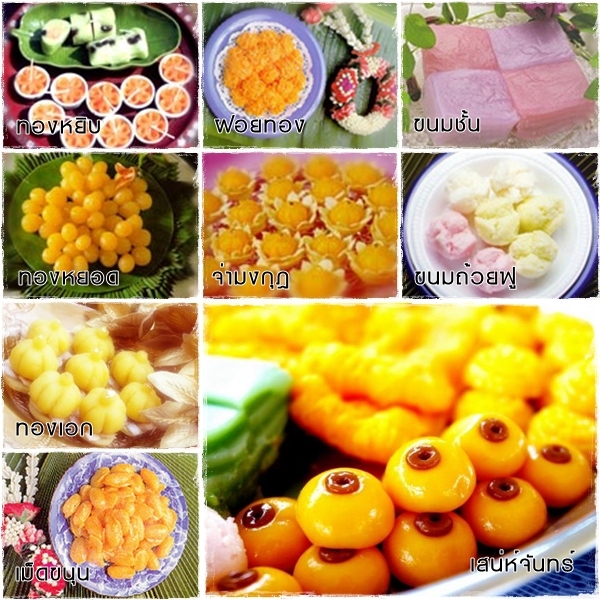
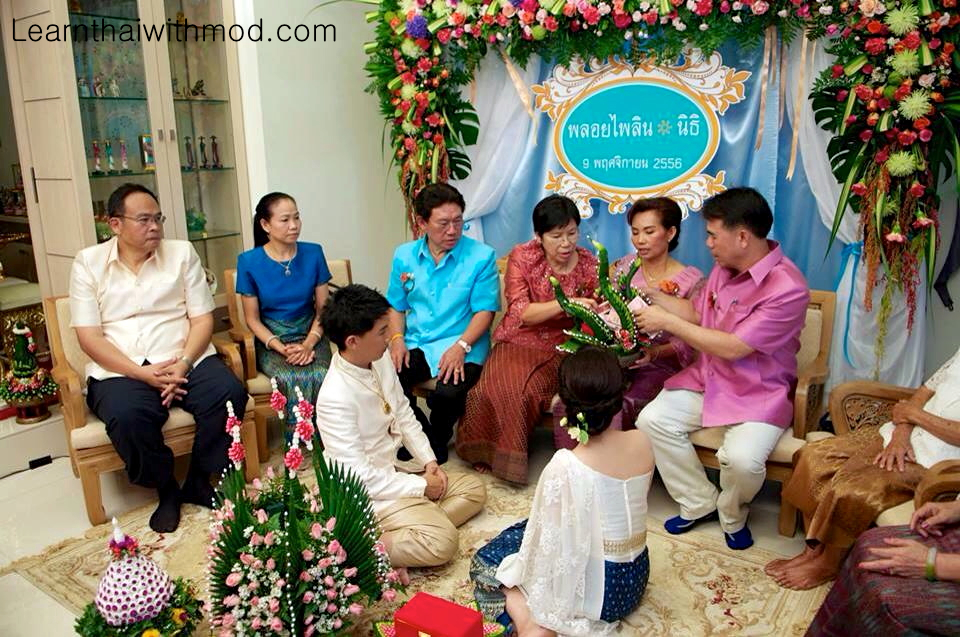
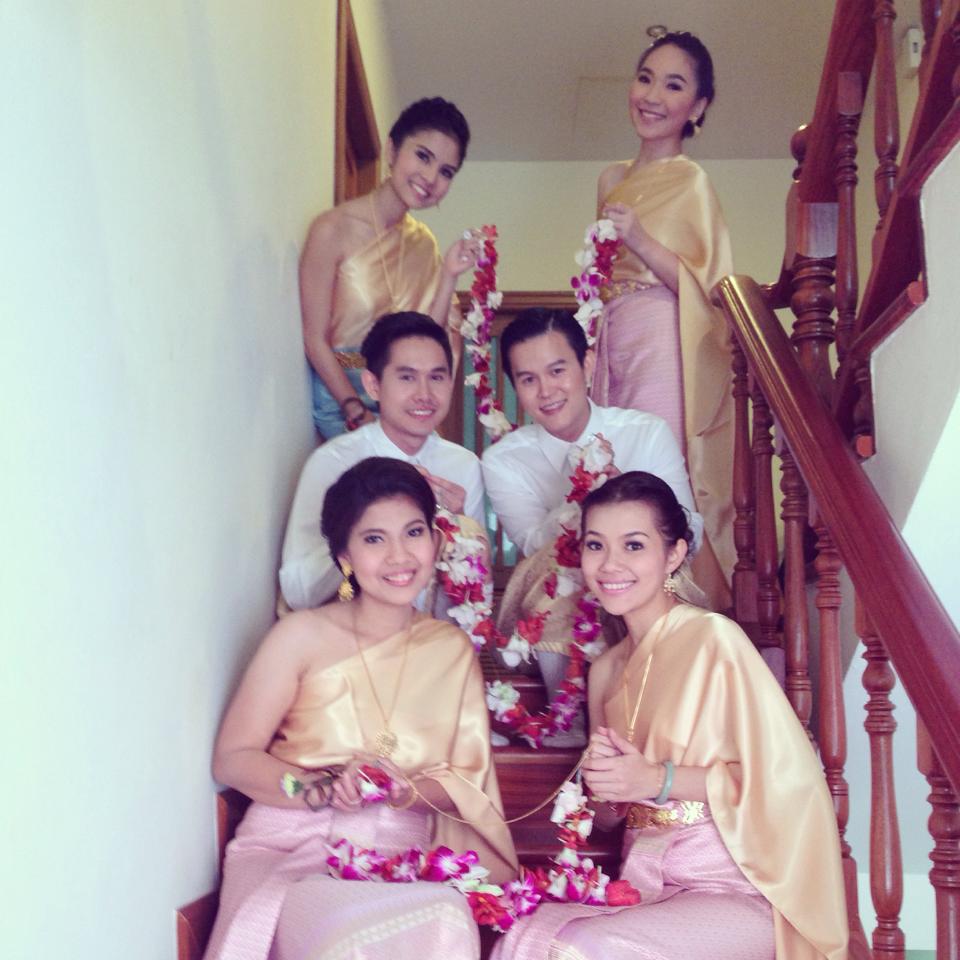
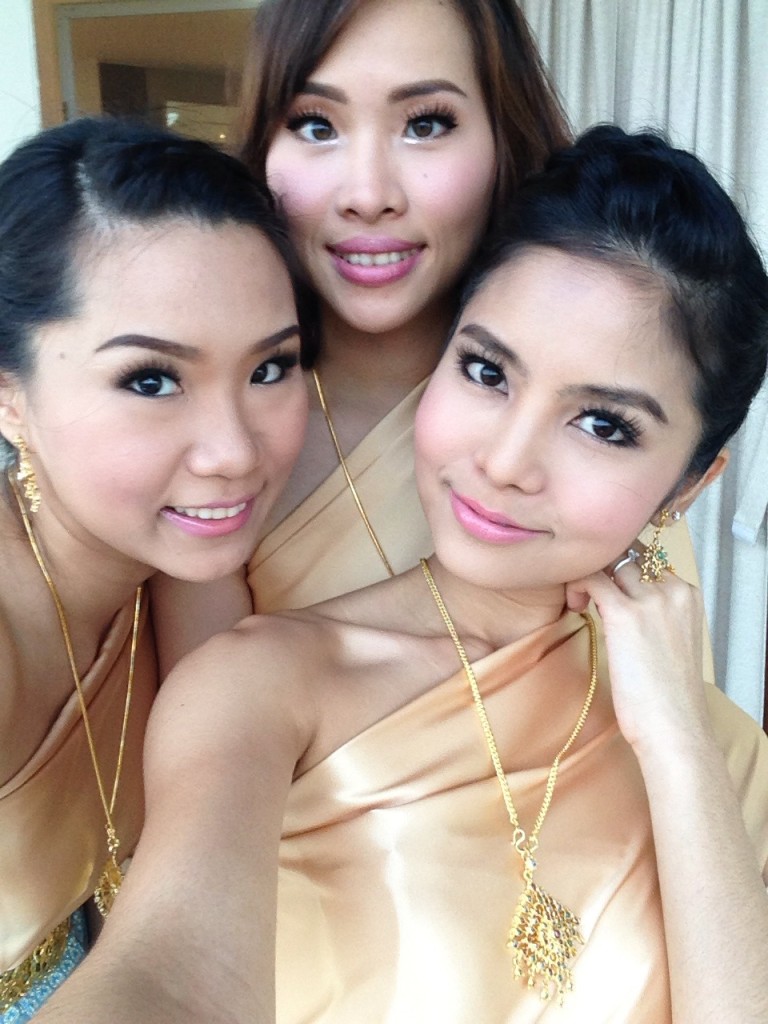
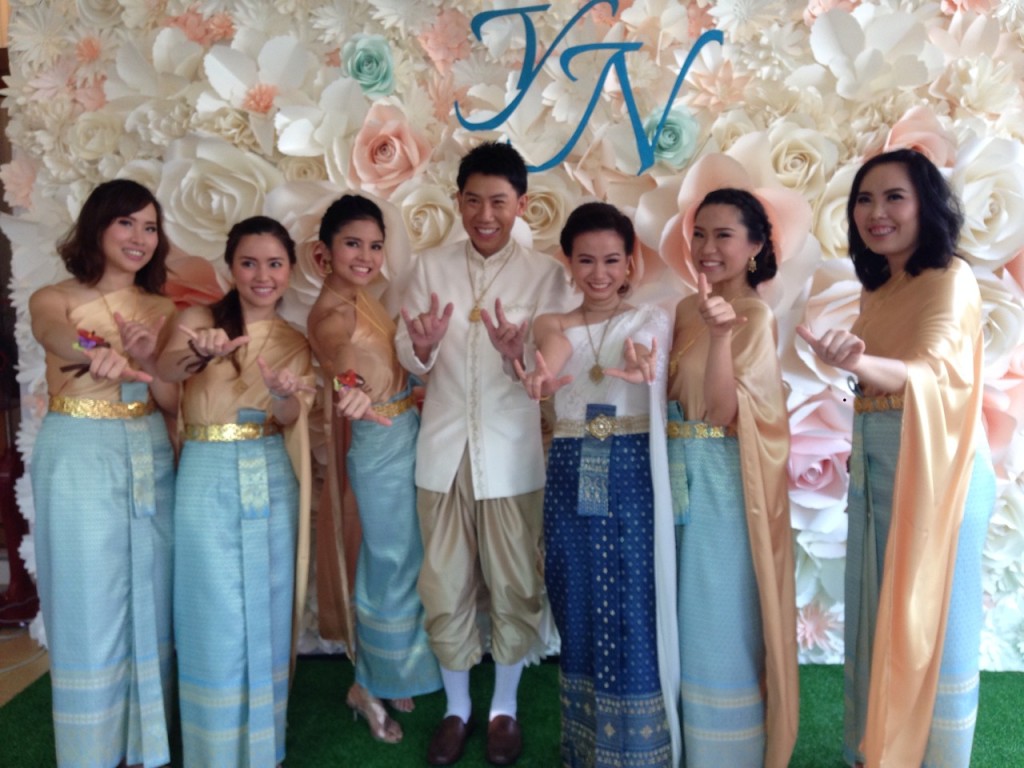
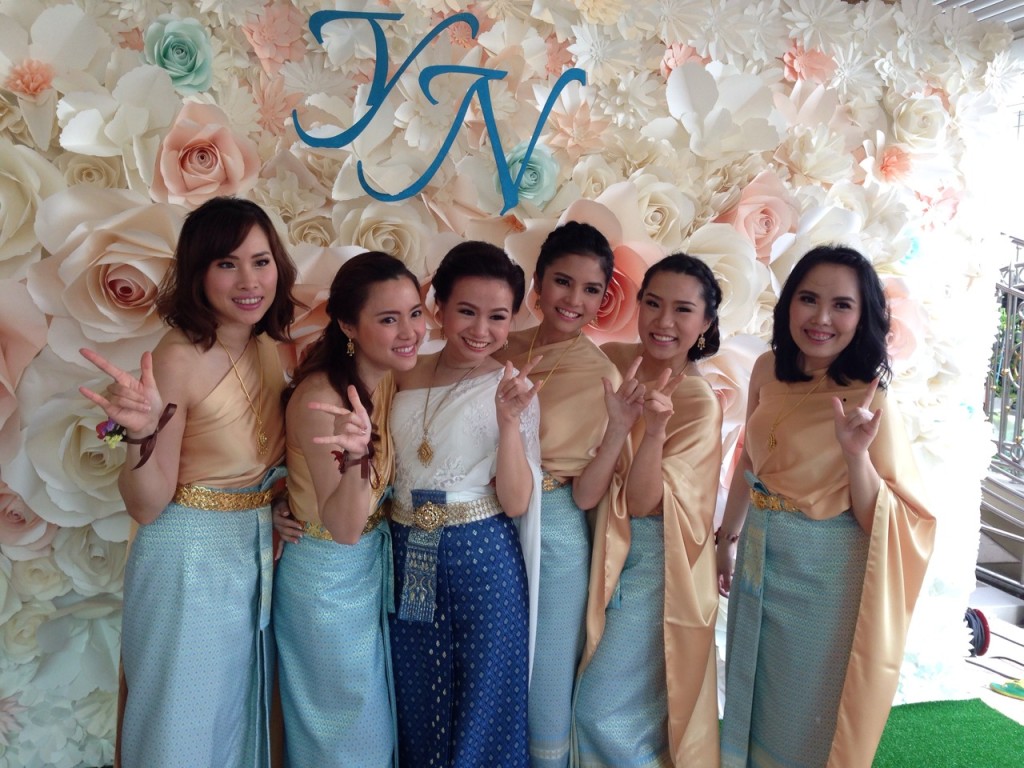
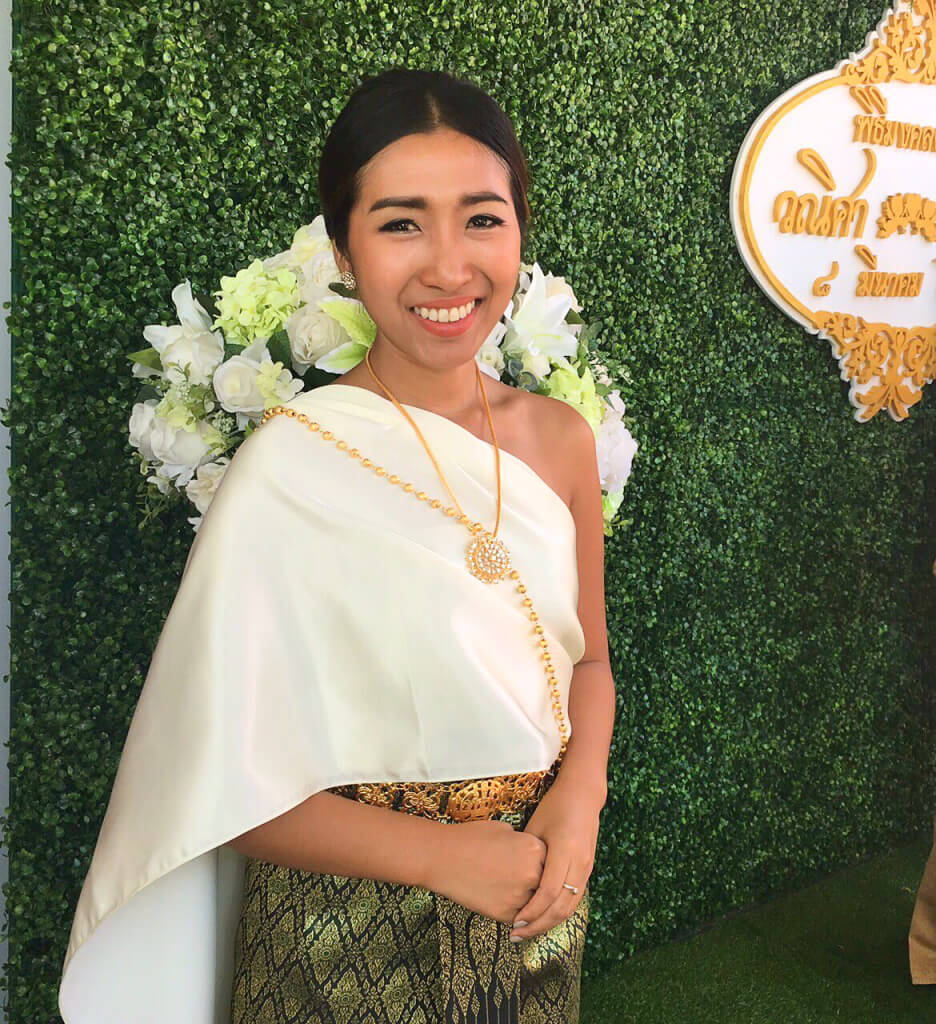
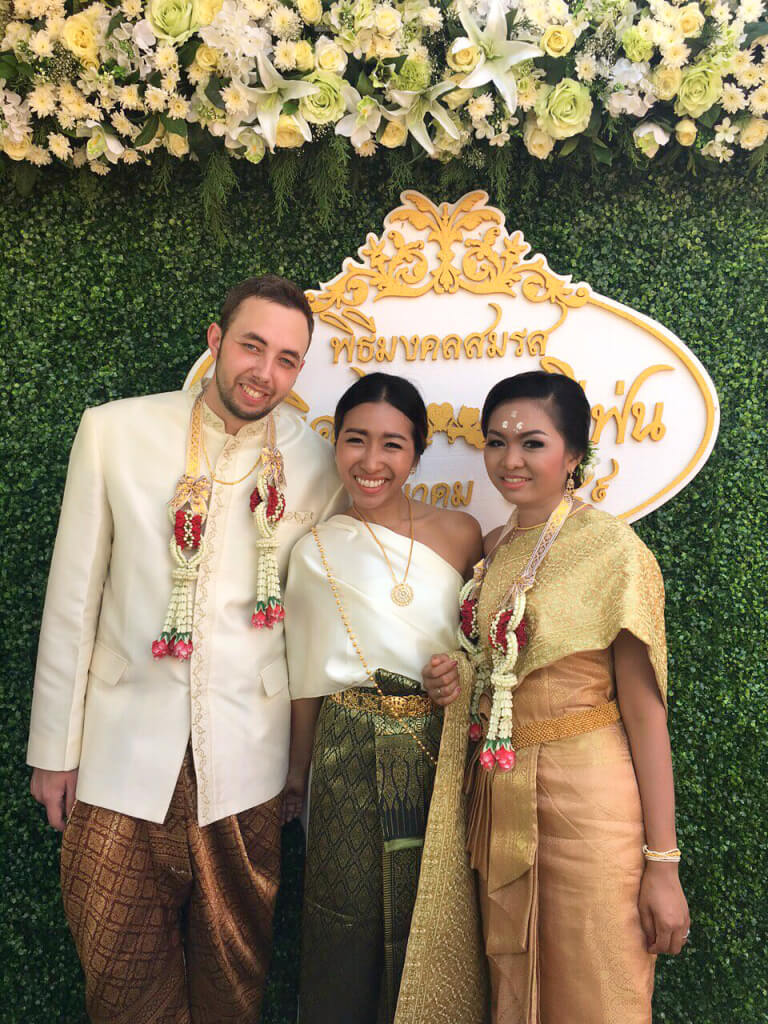
Hi Mod,
I really would like to thank you for your time to explain this ceremony, which is not so easy for farangs to find out and understand it correctly on internet.
That was a fantastic explanation and very exhaustive!
This looks like a very colorful and and meaningful ceremony, full of interesting tradition and symbolism, and all the bridesmaids are so beautiful!
Thank you for your comment Greg. I am happy to hear that you like our wedding tradition. 🙂
Hello, when you say the khan mak procession started at 9:09am, does this mean that the Groom’s side start marching towards the woman at that very moment?
Exactly. 🙂
Thank you for sharing and educating us about his important part of Thai culture.
It is our pleasure. We are happy to hear that you enjoyed the video. 🙂
This is so beautiful! I would like to see a traditional Thai wedding in person. Here in my country Costa Rica, weddings are not traditional, we do it as Americans do, with the white bride dress, in the church and then the celebration party which is the wedding reception. Soon on November I am going to get married and it would be as many weddings are. Thanks for sharing this wonderful experience from your country. Regards!
Thank you for reading my article. I am happy to hear that you enjoy learning about Thai culture and tradition. Congratulations on your wedding. It will be beautiful!
I saw the sign พลอยไพลิน นิธิ in the background, which my Google translated as Sapphire and Runaways! Is it their names?
They are the names of the groom (นิธิ means ‘treasure’) and the bride (พลอยไพลิน means’sapphire’) 🙂
Thanks a lot Kun Mod for ur sharing. Ur post is very helpful.Can I have ur basic profile..coz I’m doing my assignment about Thai wedding ceremony. But I have to mention about the person who share it too. I really need it.. Thank you
Sawatdii ka, I am happy to hear that you found my post useful. You can mention LearnThaiwithMod.com in your assignment. Thank you. 🙂
What does a western friend of the groom. Wear at the Ceremony ?
Please e mail me with answer.
Thank you
It depends on the formality of the wedding and how the wedding couple would like the guests to wear. They might arrange Thai traditional costume for their friends. If nothing is specified, male guests usually wear a smart shirt with or without a jacket and smart trousers.
สวัสดีค่ะครูมด ขอบคุณสำหรับพิธีไทยฉบับภาษาอังกฤษดีมากๆ และได้รับประโยชน์มากๆจริงๆค่ะ อยากจะขอรบกวนเรื่องพิธีรับไหว้ผูกข้อมือเป็นฉบับภาษาอังกฤษด้วยได้ไหมคะ ขั้นตอนที่จะทำคือให้ผู้ใหญ่มารับไหว้, ผู้ใหญ่ผูกข้อมืออวยพรและให้เงินก้นถุง, บ่าวสาวมอบของรับไหว้และกราบขอบคุณ ประมาณนี้ค่ะ ตอนนี้กลุ้มใจมากๆเพราะจะต้องช่วยเพื่อนดำเนินพิธีแต่งงานแต่ไม่รู้จะอธิบายเป็นภาษาอังกฤษได้อย่างไร เกรงเพื่อนต่างชาติจะไม่เข้าใจเพราะเขาพูดภาษาไทย ฟังภาษาไทยไม่ได้เลยค่ะ ขอบพระคุณล่วงหน้านะคะ
สวัสดีค่ะคุณนุ้ย ขอบคุณนะคะที่อ่านบทความของมด มดดีใจค่ะที่บทความนี้เป็นประโยชน์ มดจะพยายามเพิ่มเติมส่วนผูกข้อมือกับรับไหว้ในบทความค่ะ ขอเวลาค้นคว้าข้อมูลนิดนึง 🙂
May i ask you a question?
Where do Newlyweds live after they married?
Yes you may ask any questions. 🙂
To answer your question, it really depends on their decision. Some couples live at their own place, some couples move in to parent’s home.
hi, Mod
Thanks for these helpful information i got from this side. It was a nice moment spending times with this side and learning Thai weeding ceremony. This culture is really different compared to my own culture, and it is really interesting. I visited this side because i have a assignment for my Sociology class, and thanks for these information’s. I will keep an eyes on this side.
Thanks,
I am happy to hear that you found my website helpful. Thank you for visiting.
Hi Kru Mod, I attended my first one this past weekend (on Valentines day!) and there were a number of things which happened that I did not understand. Thanks for this writeup as it cleared up a lot of things for me 🙂
Thank you for reading my post. I am happy to hear that you found it useful. 🙂
Sawatdee ka p’ Mod! Thank you for breaking down and explaining the traditional Thai weddings–it was very informative! By any chance, do you remember how long did the ceremony last (the thread and water pouring). I think I will try to do a modified version of this in New York–I hope I can pull this off! Thank you in advance 🙂 Kop kun ka!
Sawatdee ka Nong Kat, thank you for reading my post.
To answer your question, it depends on the number of the guests. If there are many guests then it will take longer tome than a small wedding. One guest takes about one minute to pour the water and give wishes to the wedding couple:)
Loved this article – Can I ask where you had your dress made? I am getting married in Thailand in a month and love Thai wedding attire.
kop kun ka:)
Sawatdee ka Krista, thank you for visiting my website. We actually rent the dress. The bride rent it from this shop:https://www.facebook.com/mps142
Congratulations on your wedding! 🙂
Lovely
Great post Mod, very informative and beautiful wedding! I was wondering if at the end of the traditional ceremony there is a moment when everyone sit and eat together or if something different is done.
Sawatdee ka Luca, apologies for my delayed response. I just saw your question.
Usually the host will serve lunch for the guests who attend the ceremony. Some wedding couples who decide to have a wedding reception in the evening in the same day (where the big dinner is provided) might serve only light snacks. 🙂
Wow Krue Mod, I think you added a lot more to this post?? Anyway, it really is a great read and so informative kob khun krup 🙂 again 5555
Sawatdee ka Evan, thank you for reading my post. I am happy to hear you liked it. kop kun ka:)
This is great thank you, truly unique Thai
Thank you for reading my post. I am happy to hear that you liked it. : )
Khob khun Krab Nong Mod.
I learning Thailand languages from you.
Sawatdee ka Pii Marius, thank you for reading my post and watching my videos. kop kun ka 🙂
Last Thai wedding I remember there was a traditional Thai ceremony in the morning and a big party with eastern white dress and tuxedo in the evening.
Our wedding in the village in Isaan was a lot smaller than this yet fantastic and really memorable! We met through the internet and just had to be but I had never been in Thailand before – we were only together for 9 days before the wedding so it was a huge cultural chok for a Scandinavian guy like me. I followed all the preparations but understood just a little – no one but my wife spoke english! The traditional walk through the village was so much fun, I hate pink, but some family was holding a pink umbrella over my head while we walked through the village with a big truck with loudspeakers playing morlam/wedding melodies following. When we arrived at a family house I had to pass three “doors”, gatekeepers were young boys and girls and I had envelopes for each gatekeeper with 100 THB in each. After passing the doors a young boy washed my feet before I could enter the house. I have never seen my wife so beautiful as this day. The ceremony was without monks but village elders, it was loooooong and it was so hot! Had a big party outside the house, roads were closed due to the stage where young girls performed morlam singing and dancing – furthermore the guests required me and my wife on stage for questioning and for singing karaoke! It was a fantastic experience and I will never forget it – now it is 5½ years ago and still one of my best memories in life 😉
I was always interested in knowing how traditional Thai weddings worked. In India, dowry is pretty common too but it’s rare in my community (in north Kerala). It’s definitely not practiced in my family because of the social issues caused by dowry and spousal abuse demanding more money. So it’s a bit disappointing to see ‘sinsod’ and the display of all that cash. Oh well, different cultures. As long as the families don’t fight over money — that’s starting the marriage on a very sour note.
Other than that, the other similarity between Thai weddings and our own is the gold. Again, not something I’m proud of because people some people here over-do it with the amount of gold they make the girls wear. (I’m talking kilos of gold!)
That said, thanks for this. I saw wedding photos of some Thai friends and I see them in Western-style white wedding gowns and tuxedos, and I wondered if they just wore it just for the photoshoot.
The Isaan also have a layman chant prior to the ceremony with the monks. Also, I have never seen an Isaan ceremony where there was not an egg given as an offering to the spirits.
I think the Thai wedding ceremony has something in common with Chinese wedding.Like the groom has to pay “toll” to open the “doors” and meet his bride^^Very interesting,we have some same points in traditional wedding.
Hi Mod, I am living in the State of Kerala, which is in the southernmost part of India.
While I was casually surfing through your article, I was astonished to find similarities our ceremony (we are a community called Tamil Brahmins) have with “Kan Mak’. Here the engagement ceremony is called “Nishchay Thamboolam” wherein Nishchay=fixing and Thamboolam=betel nut/betel leaf tray. Is betel nut is such an important element in the Asian marriages?
Sampath
Sawatdee ka Sampath,
Thank you for reading my article. I am not sure about other Asian countries but it is important in Thai wedding. In the old time, Thai people liked to chew the betel nut, Chaplu leaf and limestone paste. If you like someone you will offer the Betel chew to that person. Today, the betel chew is used as a symbol of welcoming the bride’s family to the groom’s family. 🙂
In Hong Kong betel nut is a must in the Wedding Ceremony. I’m not sure whether it is also true for the Northern part of China. Despite betel nuts, we have also a pair of coconut.
Thanks Krue Mod, always interested in learning about Thai culture and traditions. I hope to be invited to one of these one day.